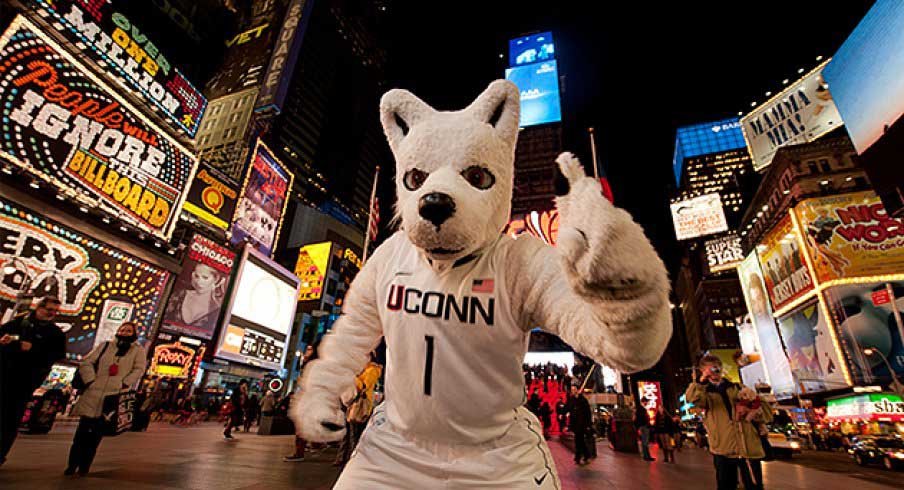Tuesday marked the beginning of a new fiscal year, ushering in a newfangled era for the Big Ten. Maryland and Rutgers became the 13th and 14th members of the century-old conference that’s seen tremendous expansion the past 25 years.
But did the league swing and miss on Rutgers? A definitive answer won’t be known for years. What’s evident at this point is Penn State, Nebraska and even Maryland’s entry into the Midwestern-based conference is a success. Might Connecticut have been a more suitable addition than Rutgers, though?
Since the conference realignment musical chairs began five years ago, one school – UConn, located 140 miles from New York City – has evolved into the attractive girl no one wants to approach. The Big Ten and ACC always lurked, with UConn believing it was destined to join one of the power conferences, but the leagues opted for Syracuse and Rutgers when it came to adding East Coast pieces and penetrating the New York market.
Nate Silver, one of the most highly regarded stat gurus in the country, compiled data and put a number on the divided New York City market. In the city where pro sports are king, Rutgers has 607,000 fans, followed by Notre Dame (267,000), Penn State (186,000), UConn (150,000) and Michigan (144,000). Ohio State’s 65,000 fans rank ninth.
Overall, a minuscule 11 percent of people in the New York area consider themselves rabid college football fans. Ohio State, Michigan and Penn State’s appeal in Gotham is more meaningful than Rutgers becoming New York’s Big Ten team. With the Big East football conference dissolving and the AAC lacking star power, the opportunity for the Big Ten to claim New York as its own is real.
Jim Delany’s goal in adding the Scarlet Knights is to gain a foothold in the New York market – the biggest in the country. By location, Rutgers fits the bill, considering its football stadium is 40 miles from Midtown Manhattan. But the program generates little enthusiasm in the bustling metropolis of eight million people.
When UConn and Syracuse come to town, they take over the city. The most recent example was the East regional, when Husky faithful gave their team a home-court advantage at Madison Square Garden. The New York Times made a bold statement in April, criticizing the Big Ten for blowing its opportunity to make an impact in the city.
“Beyond the misguided belief that it was buying its way into the New York City market, what was it thinking?” the Times opined.
Just as no one hides the fact that money is on top of the decision-making chart, the same realization exists regarding football’s importance in all things realignment. And Rutgers and UConn are similarly irrelevant. The Scarlet Knights consistently appear in bowl games and the Huskies played in the Fiesta Bowl, but both teams move the national needle the same amount – none. And Rutgers provides nothing in basketball, whereas UConn is a powerhouse.
“Football takes time, and it depends how the new staff is doing with the system that is in place,” UConn athletic director Warde Manuel said after the school’s basketball sweep in April. “My hope in the next 10 years is that we have reached the point where we are consistently competing for championships, which will drive more demand and higher ticket prices.”
Delany and Co. would never admit to a miscalculation, even after the spring yielded mountains of evidence in UConn’s favor. The men’s and women’s basketball teams won national championships yet again – four for the men since 1999 and eight for the women since 2000. In the past 20 years, athletic programs at UConn have won 15 national championships. Rutgers has won one NCAA title in its history – men’s fencing in 1949.
As the Huskies became front-page news for positive reasons, Rutgers athletic director Julie Hermann became a public relations nightmare – again. This was already on top of the Mike Rice fiasco and basketball coach Eddie Jordan’s resume snafu. But money – and football – talks.
Athletic department revenue occurs because of football. That’s even true at a basketball school like UConn, which brought in $11.1 million in 2012-13 because of the football program. Rutgers’ football stadium seats 10,000 more people than UConn’s far off-campus Rentschler Field.
The Big Ten and its network found the quickest – not the best – avenue to New York’s massive TV market, and acted. Rutgers has quadruple the amount of alumni in New York City than UConn, and it’s New Jersey location is in fertile football recruiting ground. UConn does not offer that same perk.
When Nebraska joined the Big Ten, the conference valued quality over quantity (TV eyeballs). The same didn’t occur when an invitation was extended to Rutgers.
“I respect certain teams,” Manuel said. “I don’t respect conferences. A lot of teams playing in big-time conferences haven’t won a damn thing in their careers. So I’d rather be in our conference and win them all instead of being in another conference.
“I am always going to put UConn in the best position possible.”


